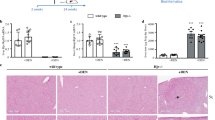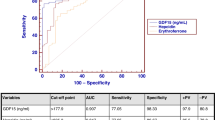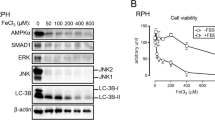Abstract
Juvenile hemochromatosis is an early-onset autosomal recessive disorder of iron overload resulting in cardiomyopathy, diabetes and hypogonadism that presents in the teens and early 20s (refs. 1,2). Juvenile hemochromatosis has previously been linked to the centromeric region of chromosome 1q (refs. 3–6), a region that is incomplete in the human genome assembly. Here we report the positional cloning of the locus associated with juvenile hemochromatosis and the identification of a new gene crucial to iron metabolism. We finely mapped the recombinant interval in families of Greek descent and identified multiple deleterious mutations in a transcription unit of previously unknown function (LOC148738), now called HFE2, whose protein product we call hemojuvelin. Analysis of Greek, Canadian and French families indicated that one mutation, the amino acid substitution G320V, was observed in all three populations and accounted for two-thirds of the mutations found. HFE2 transcript expression was restricted to liver, heart and skeletal muscle, similar to that of hepcidin, a key protein implicated in iron metabolism7,8,9. Urinary hepcidin levels were depressed in individuals with juvenile hemochromatosis, suggesting that hemojuvelin is probably not the hepcidin receptor. Rather, HFE2 seems to modulate hepcidin expression.
This is a preview of subscription content, access via your institution
Access options
Subscribe to this journal
Receive 12 print issues and online access
$259.00 per year
only $21.58 per issue
Buy this article
- Purchase on SpringerLink
- Instant access to full article PDF
Prices may be subject to local taxes which are calculated during checkout





Similar content being viewed by others
References
De Gobbi, M. et al. Natural history of juvenile haemochromatosis. Br. J. Haematol. 117, 973–979 (2002).
Camaschella, C., Roetto, A. & De Gobbi, M. Juvenile hemochromatosis. Semin. Hematol. 39, 242–248 (2002).
Roetto, A. et al. Juvenile hemochromatosis locus maps to chromosome 1q. Am. J. Hum. Genet. 64, 1388–1393 (1999).
Papanikolaou, G. et al. Genetic heterogeneity underlies juvenile hemochromatosis phenotype: analysis of three families of northern greek origin. Blood Cells Mol. Dis. 29, 168–173 (2002).
Papanikolaou, G. et al. Linkage to chromosome 1q in Greek families with juvenile hemochromatosis. Blood Cells Mol. Dis. 27, 744–749 (2001).
Rivard, S.R. et al. Juvenile hemochromatosis locus maps to chromosome 1q in a French Canadian population. Eur. J. Hum. Genet. 11, 585–589 (2003).
Pigeon, C. et al. A new mouse liver-specific gene, encoding a protein homologous to human antimicrobial peptide hepcidin, is overexpressed during iron overload. J. Biol. Chem. 276, 7811–7819 (2001).
Nicolas, G. et al. Lack of hepcidin gene expression and severe tissue iron overload in upstream stimulatory factor 2 (USF2) knockout mice. Proc. Natl. Acad. Sci. USA 98, 8780–8785 (2001).
Nicolas, G. et al. Hepcidin, a new iron regulatory peptide. Blood Cells Mol. Dis. 29, 327–335 (2002).
Roetto, A. et al. Mutant antimicrobial peptide hepcidin is associated with severe juvenile hemochromatosis. Nat. Genet. 33, 21–22 (2003).
Park, C.H., Valore, E.V., Waring, A.J. & Ganz, T. Hepcidin, a urinary antimicrobial peptide synthesized in the liver. J. Biol. Chem. 276, 7806–7810 (2001).
Fleming, R.E. & Sly, W.S. Hepcidin: a putative iron-regulatory hormone relevant to hereditary hemochromatosis and the anemia of chronic disease. Proc. Natl. Acad. Sci. USA 98, 8160–8162 (2001).
Ganz, T. Hepcidin, a key regulator of iron metabolism and mediator of anemia of inflammation. Blood 102, 783–788 (2003).
Monnier, P.P. et al. RGM is a repulsive guidance molecule for retinal axons. Nature 419, 392–395 (2002).
Nemeth, E. et al. Hepcidin, a putative mediator of anemia of inflammation, is a type II acute-phase protein. Blood 101, 2461–2463 (2003).
Bridle, K.R. et al. Disrupted hepcidin regulation in HFE-associated haemochromatosis and the liver as a regulator of body iron homoeostasis. Lancet 361, 669–673 (2003).
Ahmad, K.A. et al. Decreased liver hepcidin expression in the hfe knockout mouse. Blood Cells Mol. Dis. 29, 361–366 (2002).
Muckenthaler, M. et al. Regulatory defects in liver and intestine implicate abnormal hepcidin and Cybrd1 expression in mouse hemochromatosis. Nat. Genet. 34, 102–107 (2003).
Nicolas, G. et al. Severe iron deficiency anemia in transgenic mice expressing liver hepcidin. Proc. Natl. Acad. Sci. USA 99, 4596–4601 (2002).
Weinstein, D.A. et al. Inappropriate expression of hepcidin is associated with iron refractory anemia: implications for the anemia of chronic disease. Blood 100, 3776–3781 (2002).
Roy, C.N., Weinstein, D.A. & Andrews, N.C. 2002 E. Mead Johnson Award for Research in Pediatrics Lecture: the molecular biology of the anemia of chronic disease: a hypothesis. Pediatr. Res. 53, 507–512 (2003).
Means, R.T. Jr. The anaemia of infection. Baillieres Best Pract. Res. Clin. Haematol. 13, 151–162 (2000).
Weiss, G. Pathogenesis and treatment of anaemia of chronic disease. Blood Rev. 16, 87–96 (2002).
Merryweather-Clarke, A.T. et al. Digenic inheritance of mutations in HAMP and HFE results in different types of haemochromatosis. Hum. Mol. Genet. 12, 2241–2247 (2003).
Papanikolaou, G. et al. Hereditary hemochromatosis: HFE mutation analysis in Greeks reveals genetic heterogeneity. Blood Cells Mol. Dis. 26, 163–168 (2000).
O'Connell, J.R. & Weeks, D.E. PedCheck: a program for identification of genotype incompatibilities in linkage analysis. Am. J. Hum. Genet. 63, 259–266 (1998).
Nickerson, D.A., Tobe, V.O. & Taylor, S.L. PolyPhred: automating the detection and genotyping of single nucleotide substitutions using fluorescence-based resequencing. Nucleic Acids Res. 25, 2745–2751 (1997).
Ewing, B., Hillier, L., Wendl, M.C. & Green, P. Base-calling of automated sequencer traces using phred. I. Accuracy assessment. Genome Res. 8, 175–185 (1998).
Tatusova, T.A. & Madden, T.L. BLAST 2 Sequences, a new tool for comparing protein and nucleotide sequences. FEMS Microbiol. Lett. 174, 247–250 (1999).
Acknowledgements
We thank P. Panayiotidis and S. P. Dourakis for collecting samples from affected individuals, N. Grewal and J. Wong for technical assistance, G. Gingera for administrative support and the families for their participation in this work. This work was supported in part by grants from the University of Athens (N.S.), the BC Children's Hospital New Research Fund (G.L.), the Will Rogers Fund (T.G.), the Research Supporting Section of the Municipality of Thessaloniki (J.C.) and the Association Fer et Foie (P.B.). M.R.H. holds a Canada Research Chair in Human Genetics.
Author information
Authors and Affiliations
Corresponding author
Ethics declarations
Competing interests
Portions of this research were financially supported by Xenon Genetics, either directly (through research collaborations) or indirectly (as some of the authors are Xenon employees).
Rights and permissions
About this article
Cite this article
Papanikolaou, G., Samuels, M., Ludwig, E. et al. Mutations in HFE2 cause iron overload in chromosome 1q–linked juvenile hemochromatosis. Nat Genet 36, 77–82 (2004). https://doi.org/10.1038/ng1274
Received:
Accepted:
Published:
Issue date:
DOI: https://doi.org/10.1038/ng1274
This article is cited by
-
Pitfalls in the management of metabolic liver diseases (debate)
Egyptian Liver Journal (2023)
-
Clinical practice guidelines on hemochromatosis: Asian Pacific Association for the Study of the Liver
Hepatology International (2023)
-
Neonatal hemochromatosis with εγδβ-thalassemia: a case report and analysis of serum iron regulators
BMC Pediatrics (2022)
-
Hemojuvelin deficiency promotes liver mitochondrial dysfunction and predisposes mice to hepatocellular carcinoma
Communications Biology (2022)
-
Genotypic and phenotypic spectra of hemojuvelin mutations in primary hemochromatosis patients: a systematic review
Orphanet Journal of Rare Diseases (2019)



